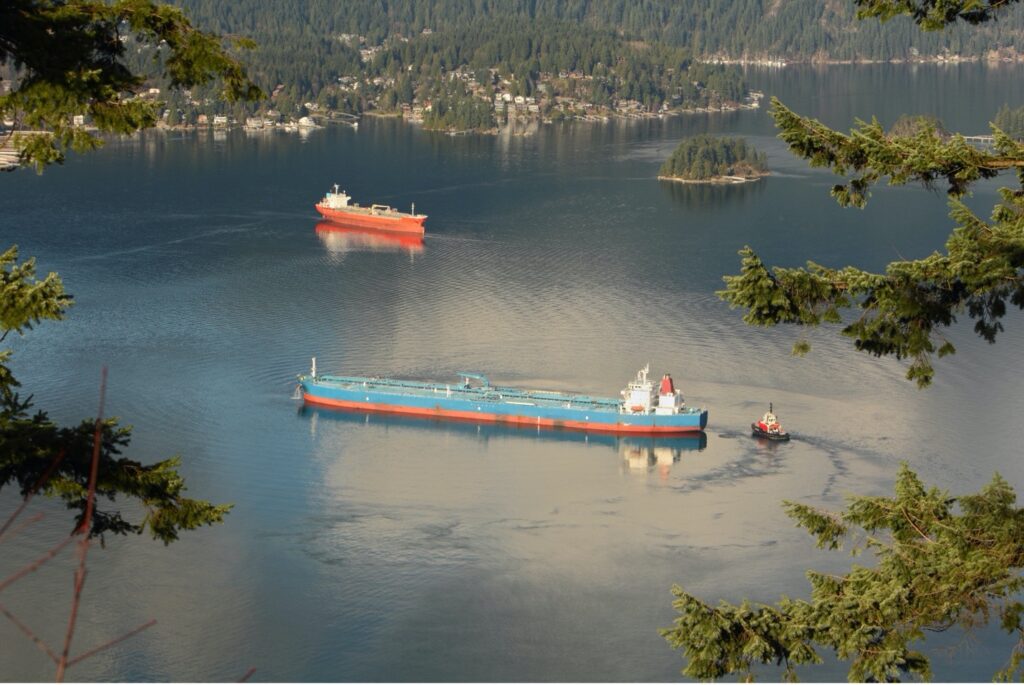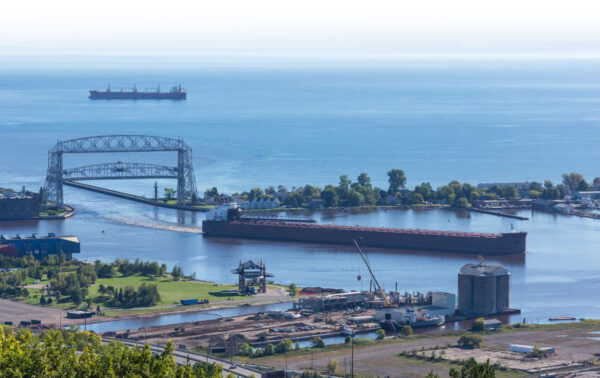The transport of oil by ships is no stranger to controversy. But the tempo of that debate is sure to increase as the Trans Mountain Expansion (TMX) project heads for completion at the end of 2022, with all three berths operating at full capacity later in 2023, placing any potential risks to coastal ecosystems from increased tanker traffic firmly in the public spotlight.
Clear Seas recently published a study on Vessel Traffic in Canada’s Pacific Region and it provides fresh insights and important context to the discussion – particularly around its impact on ship traffic through an increase in the number of oil tankers. Given that statistics are widely used on both sides of the issue to advance deeply held positions, our research team sought to ensure that the most accurate information is being considered. That is why we are releasing this updated summary that looks at the effect of the TMX project on regional ship traffic and the quantity of oil that these ships will carry. It’s important to emphasize that this analysis is not a measure of risk, but an impartial measure of vessel traffic with valuable added context. The methodology we used to calculated traffic is at the bottom of this blog.
Tankers will become more common
One certainty is that as a result of the TMX project, oil tankers will become a more common sight in the Salish Sea, likely as common as container ships. The Clear Seas analysis predicts that when the project is fully on stream, the additional tankers collecting the oil from the TMX project could represent a nine per cent increase in commercial ship traffic travelling through the Strait of Juan de Fuca, or a thirteen per cent increase in that traffic bound for Canadian ports.
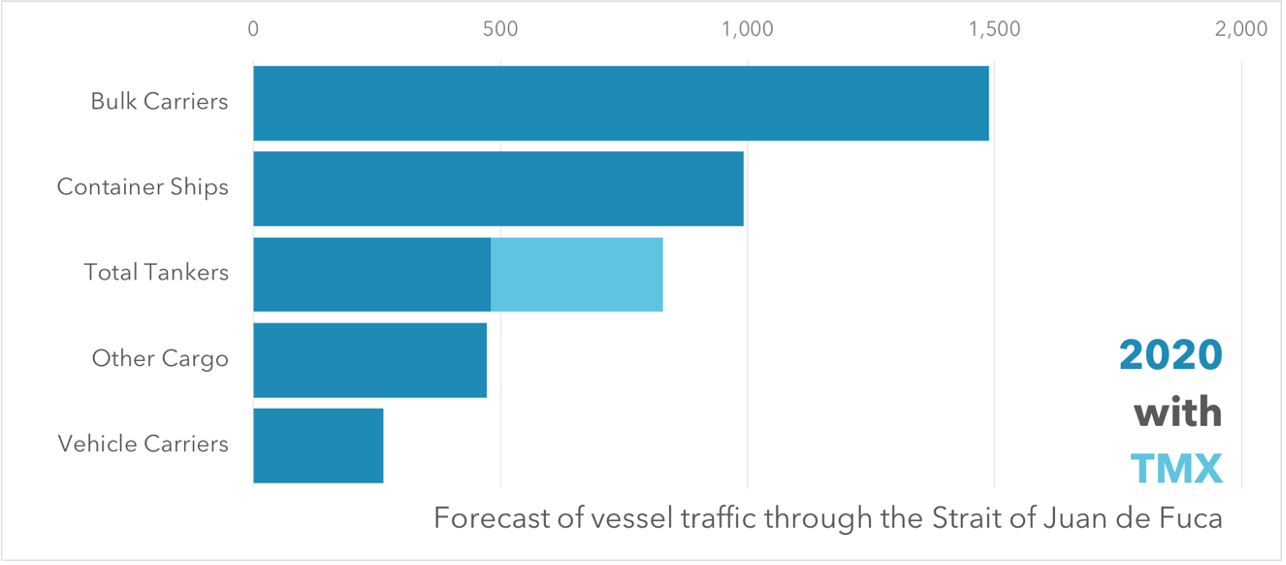
Increased shipping doesn’t mean bigger ships
Just looking at the total number of tankers doesn’t reveal the full picture as tankers come in many sizes and capacities. Many small tankers (classified as Small Handysize, Large Handysize, Handymax and Large Handymax) currently visit the Port of Vancouver to collect and deliver liquid products like fuels, chemicals, specialty products and vegetable oils. Details of this traffic are included in the Clear Seas report, Vessel Traffic in Canada’s Pacific Region (p.26).
In 2016, 87 per cent of tanker traffic through the Strait of Juan de Fuca bound for Canadian ports consisted of tankers below 50,000 deadweight tons. Their compact size relative to the larger oil tankers is illustrated in the figure below.
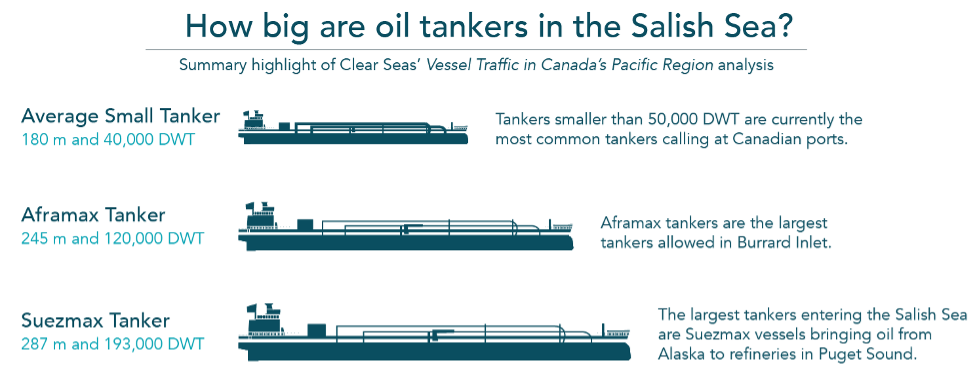
The diagram also shows the relative sizes of the two most common oil tankers seen in the region’s waters, the Aframax and the Suezmax. Suezmax tankers are most often used to transport crude oil from Alaska to the refineries in Washington State in the United States. Because Burrard Inlet (the location of the TMX offload terminal) can only accommodate smaller Aframax tankers, and draft restrictions in the Second Narrows prevent them from carrying their full capacity, it takes a larger number of these smaller tankers to carry the same amount of oil when compared to the U.S. tanker trade.
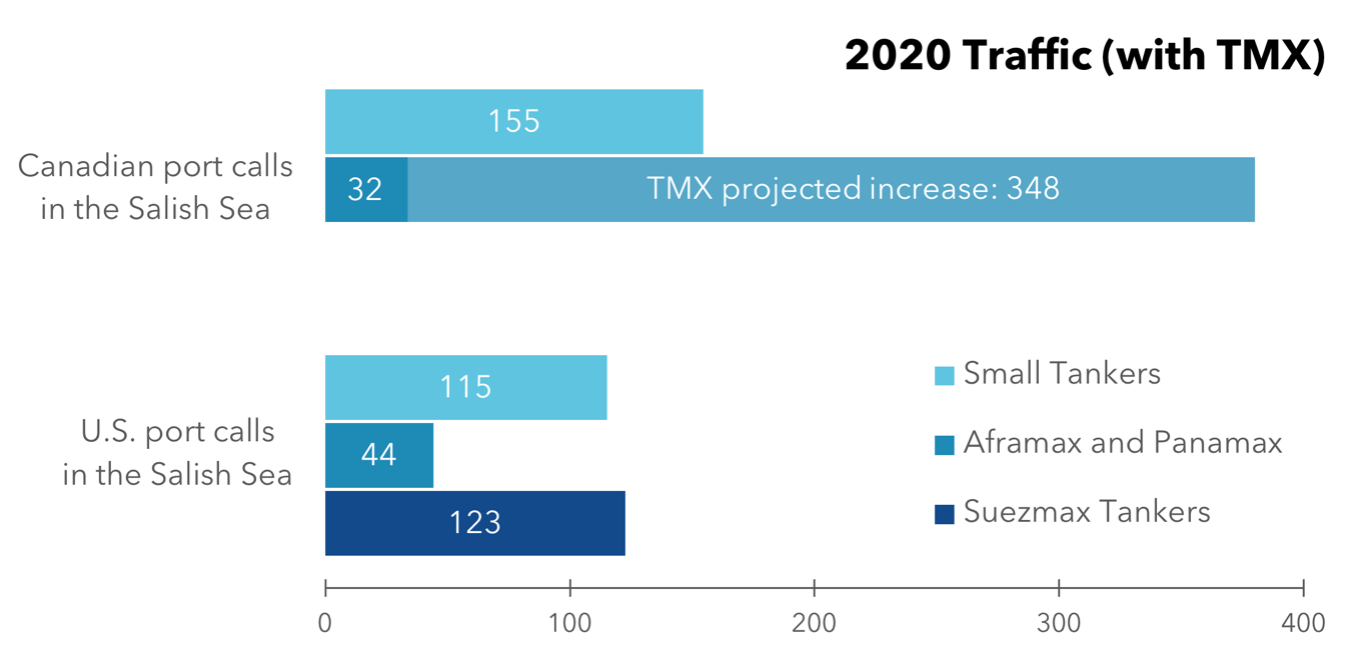
The breakdown of tanker numbers before and after the TMX project is shown in the graph above. Post-TMX, Canadian ports on the Salish Sea will become a more important destination for tankers than their U.S. counterparts with one very important distinction: because the tankers calling on U.S. ports are larger, the quantity of oil bound for the U.S. refineries will still represent the largest amount carried in the Salish Sea. And we shouldn’t neglect the oil used by cargo ships for fuel – a risk identified by Clear Seas in its original vessel traffic analysis research released in March 2021.
When the results are combined, a new picture of the quantities of persistent oil1 in the Salish Sea emerges.
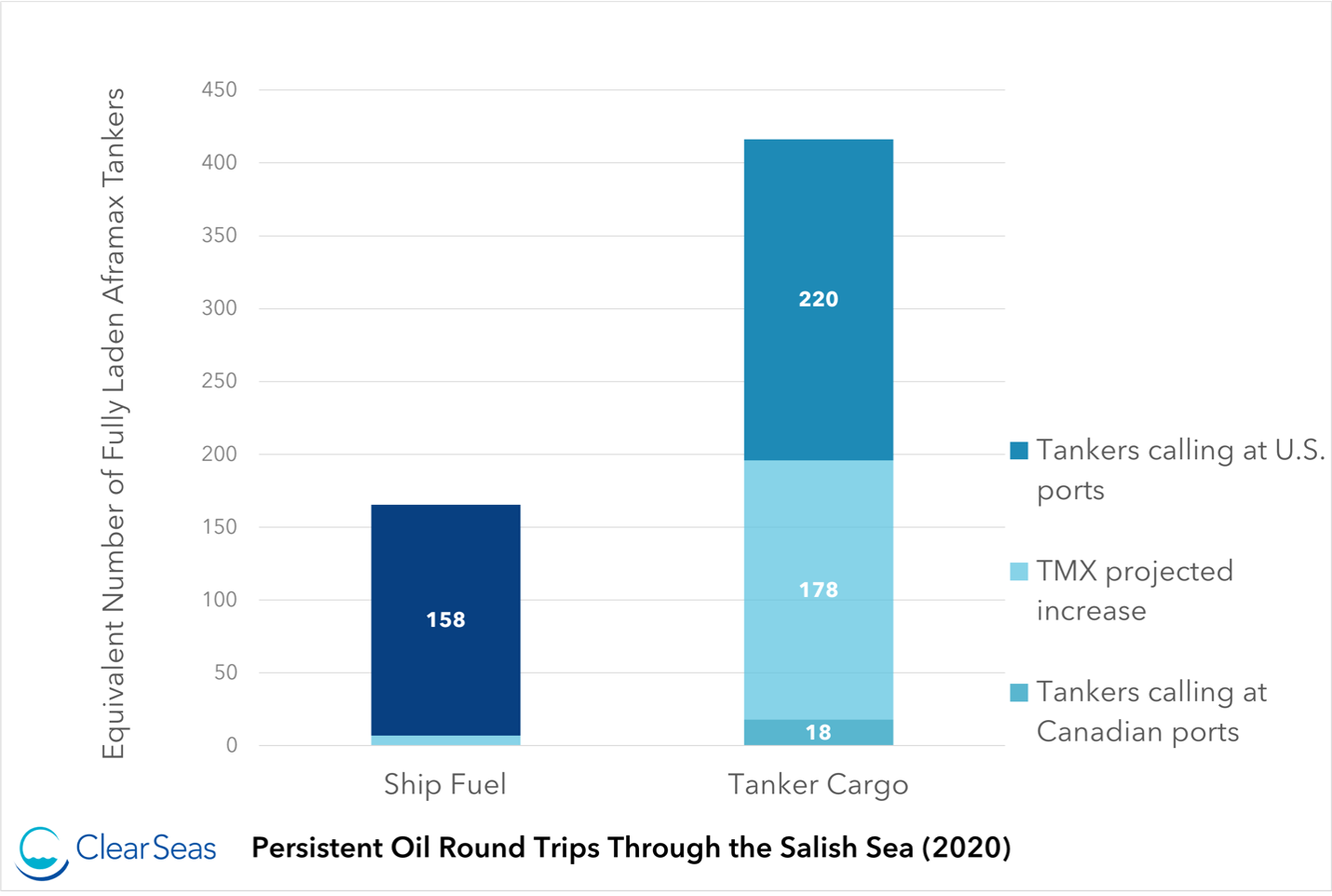
The TMX pipeline will undoubtedly change the face of shipping in the Salish Sea waters around the Port of Vancouver. In an average year, 32 Aframax or Panamax oil tankers visit Vancouver, which is slightly more than one every two weeks. Once TMX comes on stream that number will rise to an estimated 380 Panamax and Aframax tankers or just over one per day. The number of small tankers carrying a variety of liquids will stay approximately the same with small fluctuations. The debate around the risks and benefits of this traffic will continue, but Clear Seas is confident that these numbers will ensure that at the very least the discussion is using the most accurate information.
How the numbers were calculated
Clear Seas’ analysis of vessel traffic from 2014 to 2016 provides a clear picture of marine shipping along Canada’s Pacific coast, with particular emphasis on traffic entering the Salish Sea through the Strait of Juan de Fuca. This updated analysis provides a clear picture of traffic entering the Salish Sea from 2017 to 2024.2 It is calculated in two phases.

Phase 1: Correlation of port data with the clear results of the Vessel Traffic analysis
Clear Seas’ Vessel Traffic analysis sorted tanker and cargo ship traffic through the Strait of Juan de Fuca by destination, counting vessels bound for ports in Canada, the U.S., or both countries. This data was then correlated with the port calls recorded by the Northwest Seaport Alliance and the Port of Vancouver to find the ratio of port calls to traffic through the Strait of Juan de Fuca for each destination.
Phase 2: Scale the results of the Vessel Traffic analysis based on port calls and cargo tonnage data
The ratio of port calls to round-trip traffic through the Strait of Juan de Fuca was then used to scale out the results from Clear Seas’ Vessel Traffic analysis to 2020, based on port call and cargo tonnage data from 2017 to 2020 for the two ports.
The Vessel Traffic analysis also estimated the volume of oil carried as cargo and as fuel by the ships during their round-trip voyages through the Salish Sea. These numbers were similarly scaled up to estimate the volume of persistent oil travelling through the Strait of Juan de Fuca in the fuel tanks and cargo holds of tankers, cruise ships, and cargo ships in 2024. To help visualize the volumes of oil, the results are presented as the number of fully laden Aframax tankers it would take to carry an equivalent amount of oil for each category.
A geographical divide:
Passions run high on both sides of the issue, and it is often simply framed as a struggle between protecting the environment and securing the economy. A survey by the Angus Reid Institute in early 2020 shows that much of the divide is geographical with 87 per cent of Albertans supporting the pipeline and nearly 40 per cent of British Columbians opposed to it. There is also a divide among First Nation communities along the pipeline route with some who are opposing the project due to the impact it will have on their traditional lands and waters, while others are pursing economic benefits for their communities. Diving further into the disagreement, it has also created differences within communities between the elected and hereditary leadership.
Indigenous views:
The division within the First Nations communities mirrors much of the geographical split reflected in the Angus Reid poll. Speaking to The Tyee, Charlene Aleck, a spokesperson for the Tsleil-Waututh Nation along the Burrard Inlet, says the anticipated tanker traffic is “essentially in her kitchen.” She notes that more than 90 per cent of her nation’s diet came from the waters in the area before settlers arrived but that is now down to nearly none.
On the other side of the issue, Allan Adam, chief of Alberta’s Athabasca Chipewyan First Nation, who has been visible in his opposition to the oil sands, has expressed his support for a pipeline that could be built with an Indigenous ownership stake. He told the CBC, “Let’s move on and let’s start building a pipeline and start moving the oil that’s here already.“
Notes
1 Persistent oils include most crude oils (unrefined) and both intermediate and heavy fuel oils. If spilled, they last longer in the marine environment than non-persistent oils and are more likely to spread in a slick and strand on shore, potentially coating or smothering wildlife. For more information see p. 60-61.
2 This does not include some other projects that may come into service. The Vancouver Airport Fuel Facilities Corporation is expected to be in operation by 2024 generating additional traffic. Pacific Coast Terminals is also adding capacity for additional canola oil tankers in the Port Moody Arm.
References
Clear Seas Centre for Responsible Marine Shipping. (2020). Vessel Traffic in Canada’s Pacific Region.
International Monetary Fund. (2021). World Economic Outlook Update.
Port of Vancouver. (2021). Statistics Overview (2014 to 2020).
Northwest Seaport Alliance. (2020). Five-Year Cargo Volume History.
Port of Prince Rupert. (2021). Monthly Traffic Summary (2014 to 2020).
